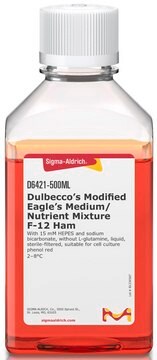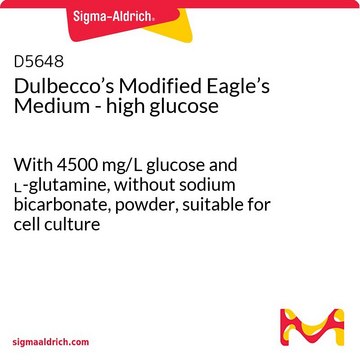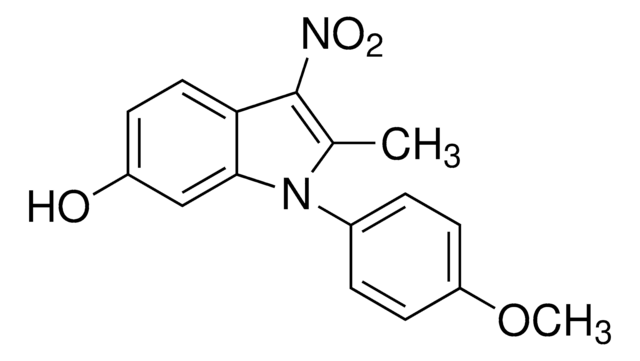D0547
Dulbecco′s Modified Eagle′s Medium/Nutrient Mixture F-12 Ham
With L-glutamine and trace elements, without HEPES and sodium bicarbonate, powder, suitable for cell culture
Synonym(s):
DME/F-12, 1:1 mixture
Sign Into View Organizational & Contract Pricing
All Photos(1)
About This Item
Recommended Products
Quality Level
form
powder
technique(s)
cell culture | mammalian: suitable
components
NaHCO3: no
sodium pyruvate: 0.11 g/L
HEPES: no
phenol red: yes
glucose: 3.15 g/L
L-glutamine: yes
shipped in
ambient
storage temp.
2-8°C
Looking for similar products? Visit Product Comparison Guide
General description
Dulbecco′s Modified Eagle′s Medium/Nutrient Mixture F-12 Ham is a 1:1 mixture.
Application
Dulbecco′s Modified Eagle′s Medium/Nutrient Mixture F-12 Ham has been used:
- to culture cerebral cortices from mice embryos
- as a component of the human corneal epithelium (HCE) media for culturing human limbal explants
- to culture human corneal epithelial cell lines
Other Notes
Trace elements include ammonium molybdate, ammonium metavanadate, stannous chloride, sodium selenite, magnesium sulfate, nickel chloride, and sodium metasilicate
Quantity
Formulated to contain 12.0 grams of powder per liter of medium.
Reconstitution
Supplement with 1.2 g/L sodium bicarbonate
also commonly purchased with this product
Product No.
Description
Pricing
Choose from one of the most recent versions:
Already Own This Product?
Find documentation for the products that you have recently purchased in the Document Library.
Customers Also Viewed
Ceyda Acilan et al.
Biochimica et biophysica acta, 1861(2), 218-234 (2016-10-25)
To overcome the hurdles of cisplatin, majorly its toxicity and resistance, there has been extensive search for alternative anti-cancer metal-based compounds. Here, three Cu(II)-complexes, Cu(Sal-Gly)(phen), Cu(Sal-Gly)(pheamine), Cu(Sal-Gly)(phepoxy) are characterized for their interaction with DNA, cytotoxicity and mechanism of action. The
Christo J Botha et al.
The Onderstepoort journal of veterinary research, 87(1), e1-e4 (2020-04-04)
Diplodiosis is an important neuromycotoxicosis of ruminants in South Africa when grazing on harvested maize fields in winter. It is believed to be caused by mycotoxin(s) synthesised by Stenocarpella (Diplodia) maydis. Although several metabolites have been isolated from S. maydis
Selma M Soyal et al.
Molecular neurobiology, 57(2), 752-764 (2019-09-01)
PPARGC1A encodes a transcriptional co-activator also termed peroxisome proliferator-activated receptor (PPAR) gamma coactivator 1-alpha (PGC-1α) which orchestrates multiple transcriptional programs. We have recently identified CNS-specific transcripts that are initiated far upstream of the reference gene (RG) promoter. The regulation of
Cristina P Matos et al.
European journal of medicinal chemistry, 176, 492-512 (2019-05-28)
We report the design, synthesis and biological studies on a group of mixed ligand Fe(III) complexes as anti-cancer drug candidates, namely their interaction with DNA, cytotoxicity and mechanism(s) of action. The aim is to obtain stable, efficient and selective Fe-complexes
Sheyda Akhshabi et al.
International journal of nanomedicine, 13, 4405-4416 (2018-08-15)
Collagen and chondroitin sulfate (CS) are an essential component of the natural extracellular matrix (ECM) of most tissues. They provide the mechanical stability to cone the compressive forces in ECM. In tissue engineering, electrospun nanofibrous scaffolds prepared by electrospinning technique
Protocols
Powdered media and salt mixtures are extremely hygroscopic and should be protected from atmospheric moisture.
Our team of scientists has experience in all areas of research including Life Science, Material Science, Chemical Synthesis, Chromatography, Analytical and many others.
Contact Technical Service









